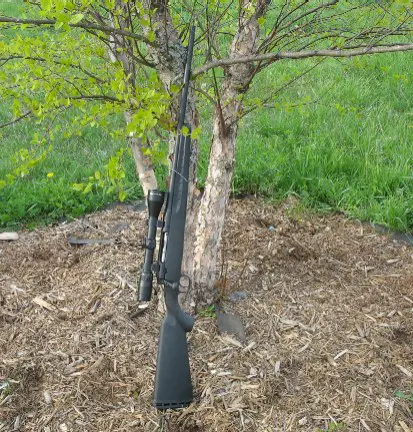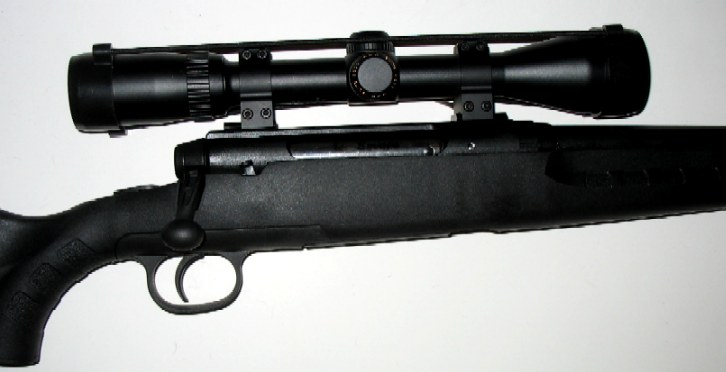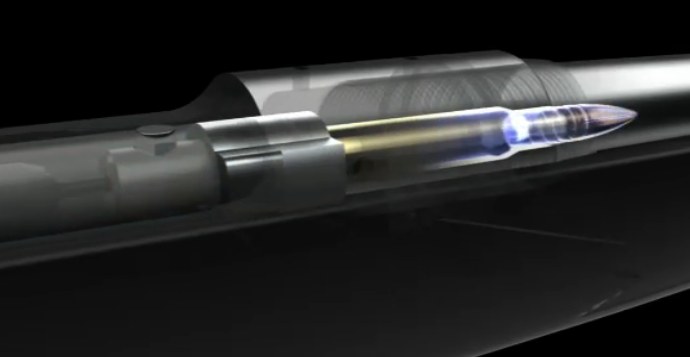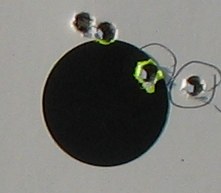


In Detail: Savage's new Edge Series Centerfire Rifles (AKA the "Savage Axis")

In this full length view of the Edge, you can spot features unexpected in an entry-level rifle. Rather than a vinyl crucifix pad or no pad at all, the Edge's recoil pad is of a soft durometer. While it may appear to be vented, the cutouts are styling accents not going all the way through the pad. The tight-radius pistol grip makes access to the oversized safety instant. The forearm sculpting and textured accents make the rifle comfortable to hold and aim and it stays put. No molded in, fragile sling attachment eyelets are present: the Edge has stronger, separate metal sling studs instead.
The new Savage Edge is a remarkable rifle in several ways, the reason I'm compelled to remark about it. The entry-level rifle market is one I generally don't talk about a great deal. Although we sometimes have a tendency to price and shop firearms themselves mercilessly, the firearm itself is such a tiny part of the overall cost of ownership once you include ammunition, range fees, optics, gasoline, hunting tags, hunting trips and so forth the cost of the firearm itself can be considered of little consequence measured against the tapestry of the full picture. Center-fire hunting rifles, in particular, if given reasonable care and attention don't wear out in a lifetime of hunting.
At the same time, affordability is important and is what a large portion of consumers want. The future of hunting and shooting sports is not that of white-haired, grumpy old men. The future of hunting and shooting relies far more on access, cost of entry, and startup costs for younger shooters. What do you say to fathers and mothers of this country that necessarily must pay close attention to the family budget when they want to have family target shooting, family hunts, and family outdoor adventures? When Dad wants to take his kids hunting and likely picks up a goodly portion of the initial starting-out costs, just what do you say to Dad? I come from a family with five kids myself, so when family mortgage payments, health care costs, food, and utility bills are on the table, just where does the family shooting sports money come from? It isn't always easy for young parents with younger kids.
Like any other sport, you hardly know what level of interest you have in it until you try it. If the family budget does not allow for it, well you just aren't likely to have an opportunity to get involved in the first place. Of course, Dad wants to get out in the field with his kids, for it was this same scenario that allowed Dad, Grandpa, and Great-Grandpa to get out there, learn, and progress in decades gone past. There are a few grumpy old men out there hunting and shooting alone or with other grumpy old men these days. I suspect they would feel a lot younger and would be far less grumpy if they were hunting and shooting with their kids and grand-kids. I hunt and shoot a lot with my father who is eighty-two years old. Dad is neither grumpy or acts old. Perhaps there is a good reason for that?
Apparently, around fourteen months ago or so, distributors and dealers told Savage Arms that what their customers wanted was good, yet affordable rifles, and that they felt there was currently a significant void in this marketplace. In what might well be some sort of a record from concept to finished product, in a little over a year the Savage Edge project was a reality.
My first reaction was “Why is this gun a Savage?” After all, the Stevens brand has distinguished itself as being the “Definition of Value,” and if there is a rifle today that reflects value, the Edge is surely it. Though Savage Arms has been around since 1894, the current Savage Arms management has it roots in 1988. It is over the last twenty-two years that Savage Arms has earned its reputation to where now “Savage Arms” on a product has a level of commercial magnetism it distinctly did not have in 1988.
It is risky business putting the company name on a new product, for a failing or substandard model necessarily tarnished the good name that took so long to build in the first place. It happens with great regularity; the examples are easy to find. Whether the recalled and ultimately discontinued Remington 710, the Sako / Tikka rifle recall, the Knight Rifles Revolution recall, or the S & W i-Bolt recall, problems such as these tend to have long-lasting effects to the detriment of brands that once enjoyed good reputations, or newcomers to the rifle market that are attempting to form a reputation. When have earned an enviable reputation, such as Savage has, you have a lot to live up to.
After pondering the subtleties of the entry-level rifle market and branding, I'm convinced that Savage made the right call in branding the Edge a Savage. The model of “Edge” is sufficiently distanced from the traditional Savage rifle nomenclature, so there can be no confusion. Savage rifles have continually been rated as exceedingly good values in general, outshooting models sold at many times their price tags, so the notion of value and Savage Arms branded product has largely been viewed as compatible, if not a given. Based on the 1/2 MOA performance of the tested Savage Edge .223, it certainly shoots like a Savage and will do nothing but continue and enhance the Savage “Definition of Accuracy” motto. There are still many, many rifles out there that cannot average even two-inch 100 yards. Savage does not not make a single rifle that shoots that loose that I know of, with even their 10ML-II muzzleloader, their 220F slug guns, and their rimfires often shooting well inside an inch at 100 yards.
After completing my own review of the Edge in .223 Remington, I became aware of other reviews of the Edge. One was in .243 Winchester, netting 1/2 inch 100 yard groups and another in .22-250 that shot 1/2 to 3/4 MOA at 100 yards. It seems apparent that the 1/2 inch accuracy I observed isn't all that unusual.
In the review, I commented on features of the Savage Edge that are desirable such as the metal sling studs compared to weaker molded in studs that are not as strong. You'll find molded-in sling eyelets on models such as the Smith & Wesson i-Bolt, for example. The additional rub is that the basic black i-Bolt hits $553 MSRP as opposed to the $329 Savage Edge-- not at all a trivial spread. While the i-Bolt might be considered an entry-level rifle as well, it isn't priced like it.
The loading port on the Edge is similar to the loading port size on some Savage target rifles at .64 inches high by 6.41 inches long. I found it to be generous with no ejection problems at all. The oval ejection port, the detachable magazines fitted to cartridge, and the recoil lug embedded in the stock that nests into the barrel all bear some semblance to the approach taken by the Tikka T3. Again, at MSRP of $595 or so for a Tikka T3, it may well be considered an entry level rifle by some, but it sure isn't priced like it.

This close-up of the Edge receiver shows the smaller radius grip that allows for quick access to the oversized safety even with gloved or frozen hands. The center-feed magazine of the Edge is beautifully nested into the stock, with nothing protruding to snag. The full-sized receiver is extremely strong, with the bolt itself operating so smoothly you'll think it is on ball bearings. The full-sized receiver, with Weaver-style bases already mounted by Savage, requires a full-length scope for easy mounting. I've used a Bushnell Elite 3200 3-9 x 40mm here, attached with Warne Maxima steel rings. Evolution Gun Works (EGW) will soon be offering a one-piece rail, just as they currently do for the similarly sized action found on Savage's new 220F MOA 20 gauge slug gun. This will allow mounting of short, stubby scopes, Red Dot sights, or whatever you prefer. The bolt lift is a 90 degree throw. It presented no problems in my scope mounting; the added benefit of the longer throw is the exceedingly light bolt lift force required.
My friend, the erudite Chuck Hawks, has used both the Tikka and the i-Bolt as his poster children for cheap rifles: http://www.chuckhawks.com/critical_look_T3.htm . More often than not, I tend to agree with Chuck. An "entry-level rifle" priced at $600 is nobody's bargain. Even the Mossberg ATR, despite its molded-in sling attachments and side-safety, at least comes in at $452 MSRP in matte black, ranging up to $518 MSRP for a few of its scoped combo. Again, price is what you pay but value is what you actually get. Dropping to $329 for the basic Savage Edge is no small feat. Finding $120 of MSRP to remove without taking away what a good rifle must do and must be is tricky business, requiring surgical selections from engineering and production.
Distinctions are now made between “hunting” rifles and target rifles as they are between hunting shotguns and clays guns as well as target rimfires and hunting guns. To the younger or budding shooter, no such luxury of dedicated use exists. When I was a kid, the most often used .22 was a Marlin model 56 “Levermatic” with a 7 shot detachable magazine which entered the family as a gift from Mom to Dad. It was used for everything you can imagine a .22 rimfire rifle as being used for. The same went for our High Standard .22 autoloading pistol, a Mauser 98 actioned .270, a 38-55, and a large number of shotguns. None were dedicated-use guns, there wasn't a great largesse of extra cash around to begin to consider that. Nevertheless, all were used for hunting, plinking, and target shooting. I won my first turkey shoot at trap over forty years ago with a High Standard Supermatic Trophy 20 gauge, not realizing back then than it wasn't a clays guns, much less a trap gun, and that a 20 gauge isn't supposed to be ideal for either. It did a fine job back then on doves, ducks, and pheasants as well. I also was unaware that I needed to use a waterfowl gun for waterfowl at the time. So was the waterfowl.
It is from this type of background that when I hear that a certain gun is a “hunting gun,” I tend to chuckle a bit. We can choose the characterize a Savage Edge as a hunting gun, I suppose, but taking into consideration the affordability sought by many shooters, it is hardly restricted to that. If you are target shooting, it is your target gun, if you are varmint hunting with it, it is your varmint gun, and if you are plinking with it, it is your general purpose utility gun. A soft-shooting, 225 yard, one half MOA gun is suited for all of those things. This type of rifle wasn't generally available back in 1962 when I started actively shooting. At a street price of $290 in 2010, that equates in buying power to $40.29 back in 1962. The Wakeman family shotgun of choice was the Browning A-5, that in 1962, began at $184.75. The “Most Talked About New Rifle in Years, the Savage One-Ten” was advertised for $112.50, in 1959, roughly triple the relative price of the new Savage Edge. Fifty-one years ago, sought-after features like the AccuTrigger, the AccuStock, and the P.A.D. recoil pad were a very long ways away.
There are a few fundamental things that the entry level shooter should expect out of his rifle, things that I expect out of a rifle. Though the best safety resides between our ears, I really have little patience for rifles that fire without a trigger pull. I've tested too many of them and when the problem is so prevalent as it has been with certain models already mentioned above that it rises to the level of a recall, I have little confidence left in that company, and even less confidence in suggesting that anyone consider a rifle like that for themselves or their families.
Customer Service is, to partially quote VP Biden, a “Big Deal.” It is a tremendously important part of the decision-making process in buying an entry-level rifle, or any rifle for that matter. A boy's first gun is a really big deal, if you are that boy. There are too many companies that do not have customer service departments that I can detect. Or, if they do have customer service departments, they are unable to either answer the phone or return a phone call. Even the best products from the finest companies can have the odd issue from time to time. Your first real rifle is an important event and the initial experiences with hunting and shooting often determine whether you want to pursue that hobby or just go chase girls. You can, of course, do both. In many ways, your first rifle is going to be more important than your fifth or twentieth rifle, and may generate future enthusiasm for or hunting and shooting, or not. It just makes good sense to rely on companies that understand this and take pride in what they produce, so you can as well.
Townsend Whelen had a couple of memorable quotes, such as “The .30-06 is never a mistake,” and “Only accurate rifles are interesting.” I'd expand a bit on the latter, as I think only accurate rifles are any fun. If you aren't enjoying what you are doing, you'll likely find something else to do with little delay. So, yes, even if the notion is affordability, good accuracy is a desirable if not mandatory trait of the rifle.

Many components comprise accuracy. Three critical areas that allow Savage product to outperform are uniform barrel quality, hand-straightened at the factory, individually headspaced rifles set to minimum SAAMI specifications, and the Savage floating bolt head that allows complete and consistent locking lug contact throughout the firing cycle. The Savage Edge maintains all three of these desirable attributes.
Though many, many components comprise accuracy, there are three areas that run through the Savage line to assure it. Savage's button rifled, hand straightened barrels offer World Championship consistency. The same tooling, the same family of certified materials, the same hand-straightening is a constant throughout the line. The barrel nut allows every Savage to be precisely headspaced to SAAMI minimum dimensions. Rather than a one-piece, solid bolt, the Edge has the same Savage floating bolt head that allows for full, consistent contact of the locking lugs throughout the firing sequence. Though all the components of accuracy are beyond the scope of this article, the three primary components of precision, hand-straightened barrels, individual minimum headspacing, and the floating bolt head are the system that gives Savage its Edge. And, the Edge's edge as well.
After reading this far, you might think that the Edge is the best .223 Remington I've ever tested, regardless of price? That wouldn't be strictly true. As it happens, I have spent a great deal of time over the years with .223 Remington rifles in general, and bolt guns in particular. About a year and a half ago, I finished up a three-gun .223 comparison featuring more upscale models, including the Ruger HM77R Hawkeye, the CZ USA 527 American, and Savage's Model 25 Classic Sporter.
The sole weak spot of the Edge is the trigger, breaking at 5-1/2 pounds which is heavier than I'd like. Going back over prior test results, the Ruger with its LC6 “improved trigger” broke at 4 lbs. 11 ounces, and although a very good looking rifle was nowhere near an MOA gun regardless of what I tried, managing 1.5 MOA, if that, at its best. The Savage Model 25 with AccuTrigger broke at 2 lbs., 11 ounces right out of the box. Though user adjustable, it needed no adjustment as far as I'm concerned. Both the Savage and the CZ turned out be honest 1/2 MOA rifles in that match-up. Though the 2008 MSRP for that batch of rifles ranged from $616 for the walnut highly polished blue Savage 25 Classic Sporter to $779 for the Ruger HM77R Hawkeye, the Edge shoots with the best of that far more expensive lot, in fact producing groups just one third the size of the cantankerous Ruger. It makes you wonder.

I must have missed this flick, though the stars look vaguely familiar. Grumpy folks like these haven't done a darn thing to make rifles more accurate or more affordable, at least not that I'm aware of. In answer to those who have asked if a new rifle can be built that is safe, dependable, accurate, and affordable by virtually everyone . . . the Edge is Savage's way of saying, "Yes, we can." It's actually more like, "Take a look . . . we already have!"
Those looking for the full-blown performance driven hunting Savage might well consider the AccuTrigger, Accu-Stock, P.A.D.-equipped 11FCNS short-action rifle that also has satin, higher polished blue. At $656, it is hardly any less of a bargain based on features and benefits. This is what I was alluding to when talking about the surgical choices that must be made by engineers and gun designers when approaching the entry-level price point. Savage has the technology for better triggers, they changed the dynamic of the entire industry with it, but in redefining the entry-level rifle, difficult choices must be made. I'd imagine this was the most difficult choice of all, knowing full well that no conventional trigger will compare favorably with the AccuTrigger, but being forced to accept that adding it would inject cost that would eliminate their ability to offer the Edge at 25% less than anything out there, including Mossberg and Remington, and 40% less than the S & W i-Bolt and similar, yet outshoot them all.
Unlike some folks, I prefer a detachable box magazine as opposed to a blind box, or even an integral box magazine so long as it is well-fitted, snaps firms into place, and doesn't rattle. Fully unloading your rifle is easier and quicker, for it is just remove the magazine and open the bolt and you are clear. Getting back into action is far faster as well, for it is just snap the mag into its well, close the bolt, and you have three shots at the ready, almost instantly. The Edge magazine, in a nod to containing costs, is very similar to the newer Savage center-feed magazines, with a plastic lip that locks into the magazine well as opposed to the metal lip that is integral with the magazine well, not the removable magazine itself in other Savage models. The Edge's stock can almost be considered a “lower,” in the modular sense as it appears that the same stock and its integral recoil lug are used throughout the Edge series. The only modification of the magazine is the blocking off at the back as necessary, contingent on cartridge to shorten it. Again, this shows the thought directed at commonality of parts to keep costs down for the consumer, with no loss of functionality.
Although molded stocks can be made economically en mass, multi-cavity molds can be a very expensive proposition in startup costs. The textured accents are stylish, perhaps not for grumpy old men, but the modernistic look of the textured surfaces combined with the semi-skeletonized bolt handle and the recoil pad vents do form a cohesive picture that is modernistic but certainly not futuristic.
Discussions about styling bring back the old college days, when we actually used to write letters, put them in envelopes, with postage and everything. Typical correspondence between father and son went along familiar lines. “Dear Dad: No mun, no fun, Your Son.” A postcard came back in a few days from my father. “Too bad, so sad, Your Dad.” So it goes with the Edge. I stop by Mom & Dad's house once in a while in the evening on the way back from shooting. I showed Dad the new Edge and a few of the groups. Dad replied, “But where's my AccuTrigger?” I agreed with Dad, of course, there is no AccuTrigger. What I offered as a wondrous solution was for Dad to buy me a new Savage Model 14 in .223, with the invisible barrel nut, bolt release nested in the trigger guard, a nice walnut stock with black fore end, jeweled bolt, high luster blue, and his AccuTrigger. Naturally, Dad could shoot it anytime he liked. Dad's reply: “You know, that Edge is starting to look prettier to me all the time. That's quite a snazzy rifle you have there.”

Prior to a little coyote calling, we traditionally take time to confirm rifles. I like a two-inch kill 220 MPBR. With less of a gusty cross-wind this time, changing ammo to Stars & Stripes 50 grain Barnes Varmint Grenade loads, the first couple of shots were a bit low and to the right of what I wanted. Three clicks to the left and three up on the Bushnell Elite and things we right where I wanted them. As Dad was looking on a these quick 100 yard shots, his impression of the Edge got even better. Sub 1/4 MOA doesn't have to mean an expensive rifle.
This may well rank among Savage's greatest accomplishments yet. For all the young men and women who never thought they could afford a new rifle that shoots inside an inch, for all the parents out there that want to get in some range time with their sons and daughters but thought they couldn't afford it, or couldn't afford a rifle of any quality or accuracy, the Edge has changed all that. Pick your choice of the most popular center-fire cartridges in the land, manage to get fifty bucks into the cookie jar for a month and a half, and you have a new rifle that you can compete in anything with. That hasn't happened for a long, long time. Now, the family can spent a lot more time actually hunting together, rather than just hunting for a rifle they can afford. Getting the best rifle you can afford isn't bad advice at all, unless you just can't afford one. For a lot of folks, now you can.
Expect
a review of a bit bigger bore Edge, the Edge in .308 Winchester, in the
very near future.
Copyright 2010 by Randy Wakeman. All Rights Reserved.


